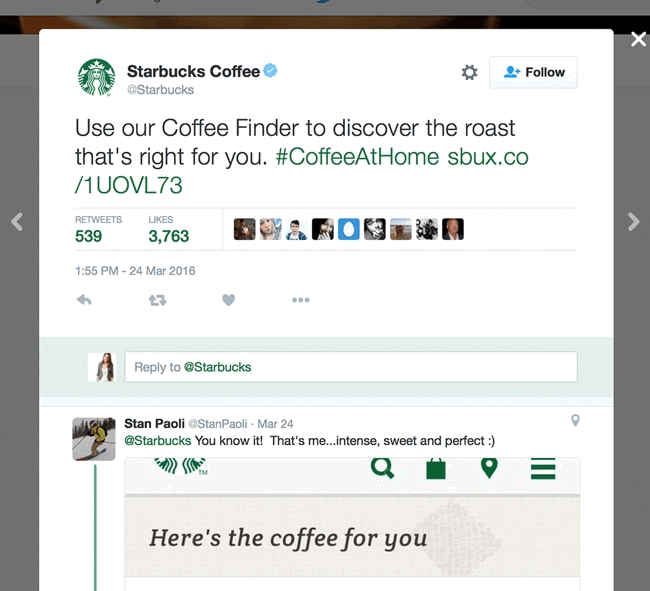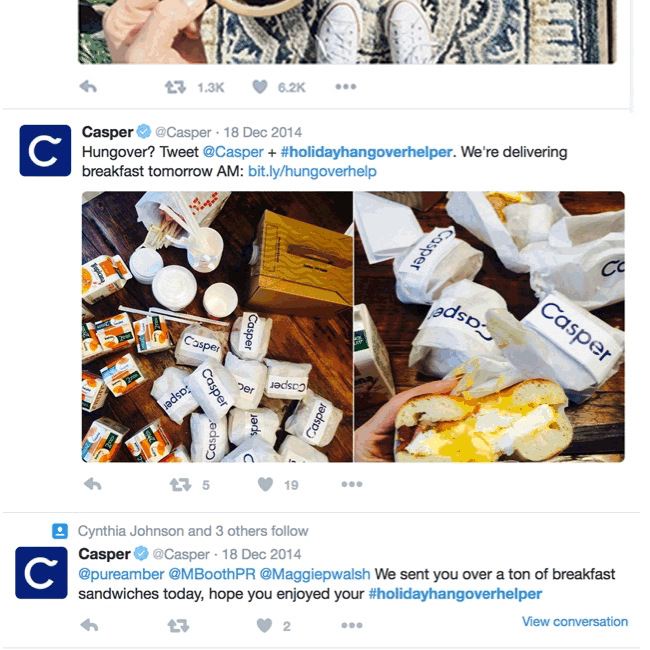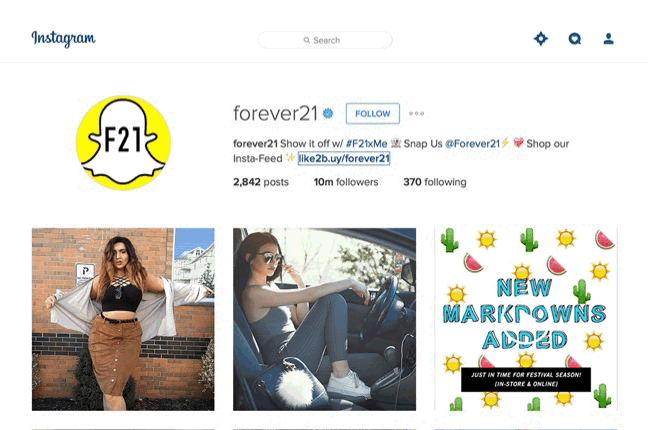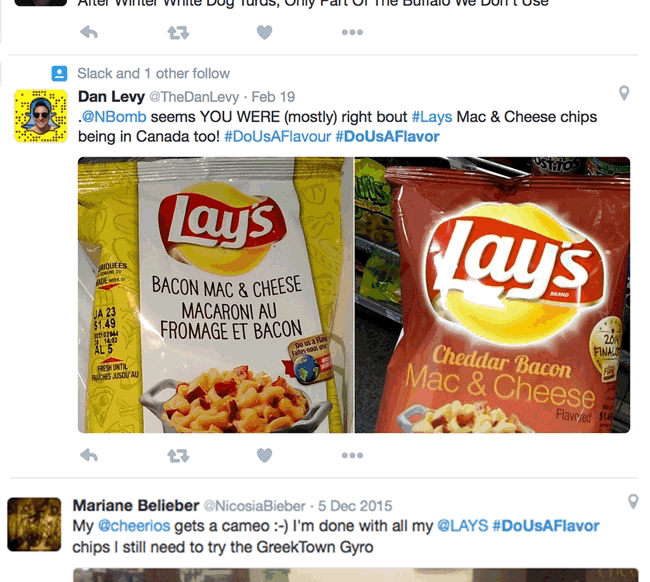Today's retailers and brands must be active on social media because that's where shoppers are spending significant amounts of time. But it's not enough to just have a Facebook page and a Twitter account, or even to simply monitor likes, shares and retweets.
Increasingly, it takes interactive activities such as contests, quizzes and polls, gamification and user-generated content. This Retail TouchPoints special report will reveal four proactive social media strategies, showing how they boost sales and raise brand profiles for companies as diverse as Starbucks, Casper, Frito-Lay and Forever 21. Success stories and key strategies include:
-
 Starbucks: Incorporate mobile at every step
Starbucks: Incorporate mobile at every step
-
 Casper: Emphasize customers' shared experiences
Casper: Emphasize customers' shared experiences
-
 Frito-Lay: Draw on consumers' own creativity
Frito-Lay: Draw on consumers' own creativity
-
 Forever 21: Simplify purchasing processes via social media
Forever 21: Simplify purchasing processes via social media
What Are The Best Ways To Measure Social Media Success?
When it comes to actually leveraging social media to improve business metrics such as sales, customer acquisition/retention, profitability or brand awareness, it's still a "good news/bad news" situation for many retailers. The jury is still out on the value of "buy" buttons, and many retailers are frustrated by the challenge of monetizing their customers' social media activity.
In addition, because social networks are growing so quickly and their relative popularity shifts so rapidly, it's often difficult to gauge precisely how they influence customer behavior.
Certainly, there are insights to be gleaned from the passive measurement of likes, shares and retweets. Retailers can also use social media activity to fuel predictive analytics, identifying product trends and making more targeted recommendations to individual customers.
"The ability to apply measurements to social media interactions is both a 'win' and a 'lose' for retailers," said Gene Bornac, VP at Boston Retail Partners, in an interview with Retail TouchPoints. "The 'win' is that there are metrics for basic engagement. More and more analysts can link these across multiple social media sites to see that this customer is engaging with us across four or five venues, and we can map their behavior together.
The ability to apply measurements to social media interactions is both a 'win' and a 'lose' for retailers
"The 'lose' is that, as with a lot of marketing efforts, they are not able to directly tie interaction and engagement on social networks with revenue generation," Bornac added. "Cutting-edge retailers know that the customer has an expectation that a brand will engage with them on multiple fronts, but for their part retailers can't get a really strong read on whether engagement actually equals revenue."
Retailers are making some progress in linking social media analytics with other forms of business intelligence. "The analytics guys are getting better and better at multi-channel attribution, and more sophisticated in understanding that customers are on four to five different devices and platforms before they visit an e-Commerce site, or walk into the store," said Nathaniel Fry, Retail Managing Director at Accenture, adding that "social platforms are wide open" in terms of sharing analytical data about users.
Four Examples Of Successful Proactive Engagement
Gamification and other interactive tools have the ability to take retailers' analytical (and engagement) capabilities to higher levels.
Retailers that may be hesitant should be aware that they don't need to leap directly into a complex campaign. "Gamification can be as simple as showing a progress bar or noting when someone moves from silver to gold status in a rewards program," said Bornac. "It doesn't have to be as complicated as a multi-stage scavenger hunt. In fact, customers don't always know there's a game going on, but they react to these inputs very well. Retailers that are plugged into this know that in all their communications with customers, there should be some element of reward to the conversation."
As an example Bornac cited Nike's program that allows customers to use the graphics-oriented Instagram network as a tool to customize sneakers. "It doesn't have to be complicated, but it does have to elicit a response."
Following are examples of four successful proactive programs leveraging social media:
![]()
Starbucks Incorporates Mobile
As with anything else in retail today, the mobile component is critical. To drive digital sales of its ground coffee products, Starbucks invited Twitter users to take a quiz designed to discover which coffee flavor is best suited to their tastes, and then to click through to a mobile-optimized shopping site to purchase a bag.
The retailer is using Promoted Tweets with a link to its three-question Coffee Finder quiz. First, users are asked which flavor entices them the most, with options including savory, fruity, toasted or caramelized. Next, they are asked about preferred sensations (crisp, smooth or lingering). The final question probes how intense drinkers like their coffee, ranging from subtle and soft through medium and balanced up through intense and robust.
Test-takers are then brought to the shopping section of Starbucks' mobile site where their individual results are displayed. They can read about the suggested flavor and its place of origin before pressing the "Shop Online" button at the bottom of the description.

![]()
Casper Emphasizes Shared Experiences
Online-only bedding retailer Casper focused on the shared experience of dealing with hangovers from too many holiday parties, asking its New York City-area customers to share party photos via social media using the @casper tag and the #holidayhangoverhelper hashtag. Winners were alerted with a tweet or Instagram comment, from which Casper determined their delivery address. Winners then received 50 hangover-reducing Black Seed Bagel egg sandwiches, orange juices and coffees delivered fresh the next morning.
The retailer also solicited pictures and videos of customers unboxing their new mattresses. To accommodate New York City's narrow hallways and numerous walk-up apartments, Casper compresses its mattresses into 41" x 21" x 20" boxes. Some of the unboxing videos have received up to 70,000 views on YouTube. Casper was honored with a Retail TouchPoints 2015 Customer Engagement Award for its programs.

![]()
Forever 21 Simplifies Social Purchasing
Forever 21 has 5.4 million followers on Instagram and receives as many as 100,000 engagements with any given image it posts, making it one of the most popular apparel brands on the network. The retailer leveraged the only active link on Instagram (i.e. the link in a user or brand's profile) to turn its photo feed into a gallery of shoppable products using the Like2Buy tool from Curalate. Because the tool works retroactively, Forever 21 was able to link existing Instagram images to product URLs, immediately driving traffic to its mobile site.
In the first two weeks after implementing the solution, Forever 21 generated:
- 47,600 visits to the gallery;
- 38,000+ outbound clicks from Like2Buy to their web site; and
- An 80% click-through rate.
During this period, Forever 21's Instagram audience became more engaged with the brand. Mobile visitors referred from Instagram averaged 19% more page views and 24% more time on-site than the brand's average mobile user.

![]()
Frito-Lay Calls On Consumers' Creativity
Frito-Lay has conducted its "Do Us A Flavor" contest annually since 2012, asking consumers to submit location-inspired flavor ideas for its Lay's potato chips. The winning flavor is put into production, with the winner pocketing $1 million or 1% of the product's net sales for a given period, whichever is higher. (Hailey Green was the 2015 winner, for Southern Biscuits and Gravy).
Use of social media (along with other promotional channels) helps the brand generate "a tremendous number of submissions," said Jerry Sheldon, Analyst for IHL Group. "This accomplished a number of things for them. It showed that this brand cared about these people as individuals but also promoted their sense of community by sparking people's creative juices — and it also gave Lay's a new product.
"By taking a multi-pronged approach to their advertising and promotion, Lay's was able to engage not just with people who liked their product, but even with people who didn't already have an affinity," said Sheldon in an interview with Retail TouchPoints. "They brought up brand awareness and also linked themselves with innovation in people's minds."

Engagement: Yes. Selling: Maybe.
Contests and other forms of gamification also keep direct selling at arm's length over social networks. That makes sense given the nature of these networks and how consumers interact on them. Industry experts recommend that retailers keep their expectations modest when it comes to generating direct sales via tools such as "buy" buttons.
"Social networks need to be understood within the context of the customer journey," said Accenture's Fry in an interview with Retail TouchPoints. "We all know that customers are highly influenced by what their friends say, so the social platform is very good for the 'research' portion of a purchase." The actual purchase make take place several steps later, on a completely different platform or device.
Retailers that use social networks to create a sense of community with consumers need to tread extra carefully. "People like the community influence, and it's powerful," said Sheldon. However, when it moves into a sales relationship, "it's almost like the change when a friend of yours gets into multi-level marketing. The friendship was a safe place for both of you, until your friend tried to sell you something. That's kind of how I view social media and sales; you're mixing purposes."
Social networks need to be understood within the context of the customer journey.
In contrast, engaging with customers to, for example, reinforce a brand image, puts far less pressure on social media users. Such actions also meet the primary goal of proactive actions — eliciting a response.
"For a long time, retailers had felt that the only way to engage with customers was to provide the lowest price, or by running periodic sales," said Bornac. "Now they're seeing that they can create loyalty by getting customers engaged so that they feel there's something in it for them. Engagement reaches back to basic social interactions, like sitting around the fire and talking about your day. Whether it's using gamification, conversations or soliciting user feedback, it feels primal, and customers enjoy the conversation."
In short, retailers should adjust their expectations around turning social media into the next blockbuster sales channel. However, as a vehicle for building community, channeling excitement about a product, service, or cause, tapping customers' own creativity or simply "gamifying" key portions of the customer journey, social networks offer a uniquely valuable set of tools — as well as a rapidly growing audience of consumers.
Questions? Send us an email at info@retailtouchpoints.com.
Copyright © 2016 Retail TouchPoints. All Rights Reserved.





 User-Generated Content: The Power Of Unscripted Moments
User-Generated Content: The Power Of Unscripted Moments 